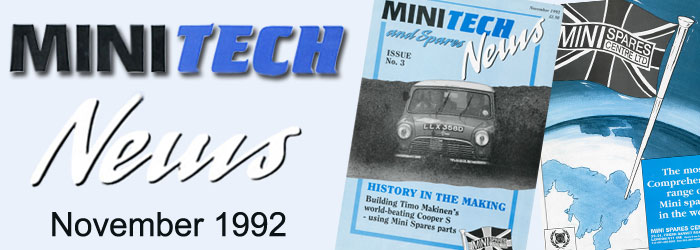In the first issue of Minitech News we covered our Stage One Kit for the998cc showing showing the power gained by its installation. Part of that kit is Mini Spares’ own alloy inlet manifold. In the second issue we outlined the details of its production and increased flow potential.
Historical Article - Nov 1992 - Air Raid
Air, so far hasn’t been subject to privatisation, consumption charges, or tax, so you may well use as much of it as possible. What better way to use it than getting as much of it as possible into your engine – it tends to help power output considerable!
In the first issue of Minitech News we covered our Stage One Kit for the998cc showing the power gained by its installation. Part of that kit is Mini Spares’ own alloy inlet manifold. In the second issue we outlined the details of its production and increased flow potential. It became apparent that this and our say so that these manifolds are super-efficient was not enough for some people – a direct flow comparison against the other available manifolds was required.
To this end I contacted a colleague and friend, Mike Parry. Mike worked closely for some time with David Vizard before returning to England to set up his own performance company – Race Techniques. I asked Mike to flow test our manifolds in the same manner as David did in his renowned bible “Modifying the A Series Engine” on his Superflow 300E flow bench. This would afford very close comparison to the figures listed for the then available manifolds.
A modified 1300cc head was used to establish the following results:-
Mike commented that he was especially impressed with the large port manifold but felt the ports were a little large for engines under 1380cc – which is good news as that is exactly what we designed it for! This positively illustrates that the Mini Spars manifold is superior in performance to those previously available. A bonus being that they are far easier to fit and give more clearance for filters etc. which was the way we designed them. Mike also commented on a strange and massive resonance developed by the Titan manifold that may reduce air flow in an “on car” situation.
There have been one or two comments made by users that they have had problems getting manifolds to seal properly when used with tubular exhaust manifolds. The reason for this is simple – inconsistent flange thickness on the exhaust manifolds. Depending on the manufacturer of the exhaust manifolds, the flanges vary from .300” (5/16) to 9mm. As we only sell Maniflow, this problem is rare as we have agreed a specific flange thickness with Maniflow to minimise this problem. This size is now 8mm.
For those who have a flange thickness difference, there are a number of ways to get around the problem:-
- File half the thick manifold washer down the relevant amount, and ensure when tightening the nuts that the relevant stepped halves are contacting the desired flanges.
- Using a round file, file the washers across the centre to make a “channel” across the washer face, then drill to hole slightly oversize. Position the washer with the channel over the manifolds join and tighten carefully. This will allow the washer to tilt into the required position.
- Drill the stud hole out slightly oversize, then run two beads of weld parallel to each other one either side of the hole. These should be lined up on the manifold flanges when tightened down. This has a similar effect to (2).
- Cut shims to the thickness of the difference between the two manifolds. These will have to be placed carefully under the relevant side of the washer when being tightened. It is possible to use super-glue or something similar to attach the shim to the washer. The main problem with this way is that the shims tend to fall out when removing the washers for whatever reason.
- One I have used successfully on occasions is to use some small, thick section angle iron, cut about 1” long. Drill a 11/32 hole though the base of the ‘V’ section in the centre of the price. Fit them with the sharp edge facing out to the nut. When the nut is tightened, the edges of the angle push down on the flanges tilting into position.
Any of the aforementioned ways will enable you to fit our manifolds when using exhaust manifolds from different manufacturers
Importation rules regarding vehicles are very specific: Only those over 25 years in age may be brought in to the USA without compilance to Federal Motor Vehicle Safety Standards (FMVSS).
Author
admin

